-
1 of 253523 objects
Mars and Venus 1815-19
Marble | 208.0 x 137.0 x 65.5 cm (whole object) | RCIN 2038
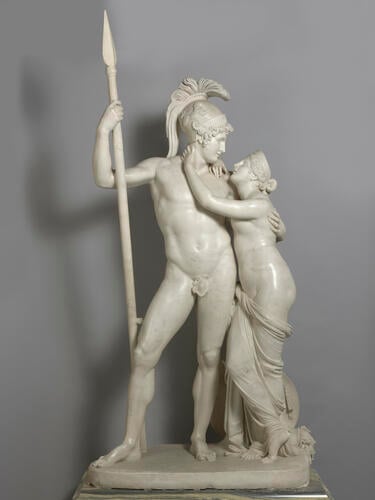
Antonio Canova (1757-1822)
Mars and Venus 1815-19
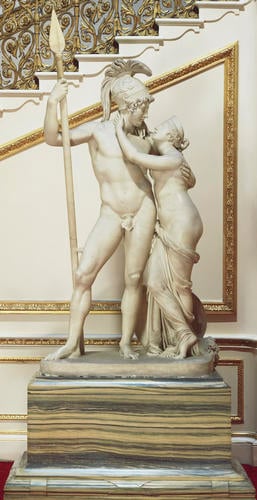
Antonio Canova (1757-1822)
Mars and Venus 1815-19
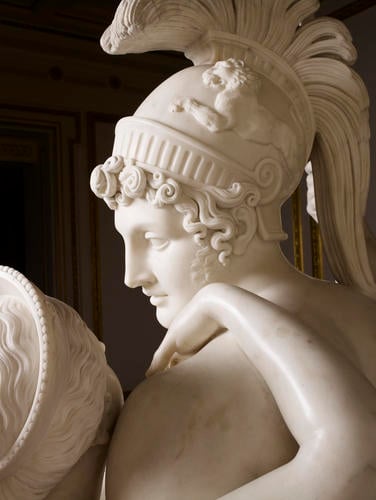
Antonio Canova (1757-1822)
Mars and Venus 1815-19
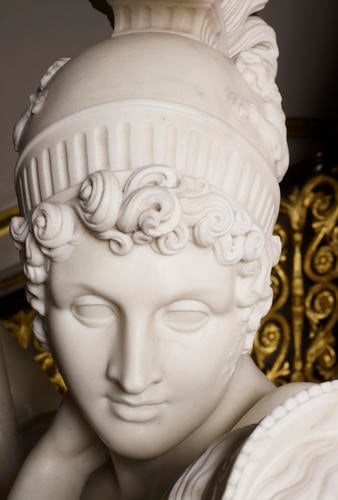
Antonio Canova (1757-1822)
Mars and Venus 1815-19
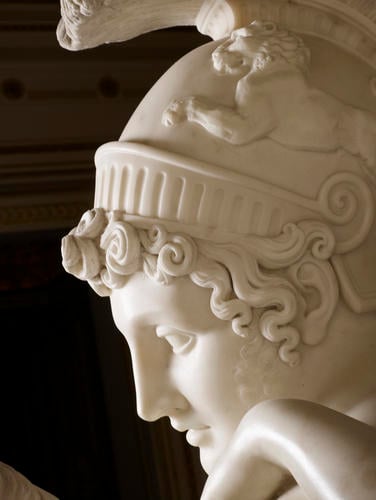
Antonio Canova (1757-1822)
Mars and Venus 1815-19



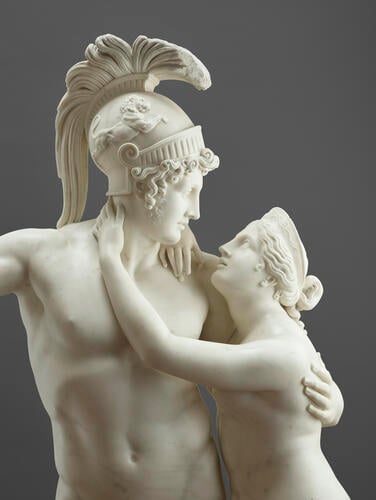
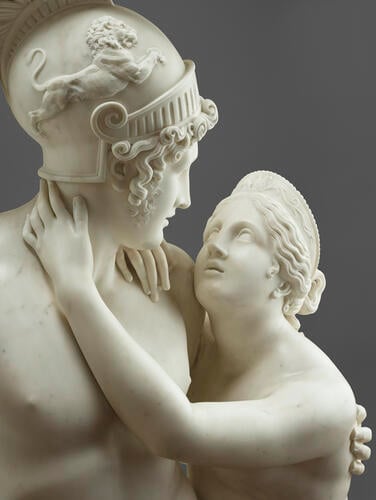

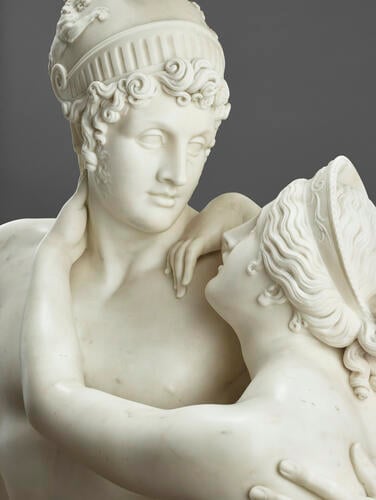
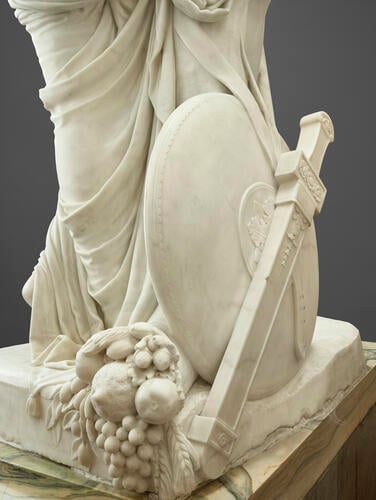



-
A full-length marble statue of Mars and Venus, standing, carved from a single block. Venus stands partially draped gazing upwards at Mars, who wears a plumed helmet with a rampant lion in relief on each side and holds a spear. Venus wears a diadem. At the back, the gap between the figures is filled by a tree stump which is partly covered by Venus's drapery. Mars's sheathed sword hangs from its belt across his circulate shield, which is propped agianst the tree. The centre of the shield is carved with stylised foliage in low relief. Nearby lies a cornucopia filled with fruits. The tip of the spear and the shaft above Mars's right hand are formed of painted wood.
This magnificent sculpture of the Roman Gods ‘Mars and Venus’ was carved from a single marble block. It was commissioned by the Prince Regent for Carlton House in 1815 during Canova's visit to London. It represents an allegory of Love and Peace after England’s victory over Napoleon at the Battle of Waterloo in 1815.
Canova visited England in early November 1815 to secure financial assistance from the government for the practical business of returning to Rome the antique sculptures and other works of art removed by Napoleon under the Treaty of Tolentino (1797). There had been rumours earlier in the year that the Prince Regent contemplated employing the sculptor on some unspecified project, and Canova was received at a levée at Carlton House on 4 December, when he conveyed a message of thanks from the Pope for British assistance in the repatriation of works of art. The prince gave the sculptor a jewelled snuff-box incorporating his cypher and containing £1000. It seems to have been agreed that Canova would undertake an ideal group for Carlton House, but the subject and design were not yet specified. It had been decided by 17 January 1816, when Canova wrote to Leopoldo Cicognara, President of the Venice Accademia, of the number of commissions he had lately received from English patrons: ‘per il Principe reggente farò un gruppo ideale di Venere e Marte, simboleggianti la Pace e la Guerra.’ (for the Prince Regent I am making an ideal group of Venus and Mars, symbolic of Peace and War). Strictly speaking the group represents not Peace and War, but Love and War. Mars’s warlike passions are not being assuaged but replaced by passions of another kind.
Canova later told Frances, Lady Shelley, a frequent visitor to his studio in Rome, that the idea for the group occurred to him as he waited at Dover for the packet on the first leg of his return journey to Rome, but we should not imagine that the composition came into his mind fully formed at this time; on the contrary, it had clearly been one that he had been contemplating for many years, as had other sculptors, inspired no doubt by the ancient group formerly in the Borghese collection in Rome. In 1805 Luigi Acquisti (1745–1823) made a colossal two-figure group on this subject for G.B. Sommariva’s Villa Carlotta at Tremezzo on Lake Como (where it remains). The Austrian sculptor Leopold Kiesling (1770–1827) made his own version, incorporating a figure of Cupid, under Canova’s direct supervision as part of a Rome scholarship awarded by the Austrian emperor.
Charles Long, who had known Canova for thirty years, acted as intermediary in his dealings with the Prince Regent. In early May 1816, Long wrote that the prince was pleased to hear Canova was already occupied on his commission, and by August he was urging all speed, requesting a drawing for the prince’s approval. Canova had started to model in clay by 12 August, and the full-size clay model was under way by 23 September. It is clear from the correspondence that the group was intended to stand in the Circular Room at Carlton House, where it would have commanded an axis extending from the Crimson Drawing Room to the Throne Room.
The progress of the carving of the group in marble seems to have been repeatedly halted by the discovery of faults in the material, a constant hazard for the sculptor in marble, since a block can appear perfect but contain veins and inclusions deep inside. The roughing-out was apparently undertaken by Adamo Tadolini (1788–1863). Mars and Venus remained in Rome after the sculptor’s death in October 1822 and did not finally arrive in London until April 1824. Canova’s account for the group does not survive in the Royal Archives and the agreed price is not known. W.R. Hamilton (the British diplomat, then in Rome) wrote to Long on 12 August 1825 to inform him of the acceptance by the Abbate Canova ‘of the offer which you authorized me to make to him, of 5000 guineas for the two last works of his brother purchased by H.M.' (including this one), 'I cannot say that he is perfectly satisfied that you pay the full amount of what they are worth, or of what his brother would have expected from them, but I am persuaded he is highly flattered that these his brother’s latest finished works, should be deposited in the palace of the King of G.B., to whom he considers himself, as his brother did during his lifetime, so mainly indebted for the halo of glory which shed fresh lustre over Canova’s last days'.
When this composition is compared with the sculptor’s earlier two-figure group, Venus and Adonis of 1789–94, the relationship of the figures can be seen to have assumed a far greater intensity and sensuality. There is a palpable tension in the goddess’s restraining gestures, and the continuous gap between the two parallel bodies, a technical tour de force, seems to be charged with electricity. The touch of Canova’s chisel is unmistakable in the details of the heads, and the broad handling of the lion relief on the helmet. There is also a sense, however, that not quite enough space was left to accommodate peripheral details; the rather under-sized cornucopia – symbolising the fruits of peace – seems to have been squeezed into the composition.
Quatremère de Quincy, in a lengthy discourse on the group and its classical antecedents, saw it as a direct result of Canova’s study of the Elgin marbles during his visit to London. The sculptor admired the Parthenon sculptures for their ‘imitation of beautiful nature, having nothing affected, exaggerated or hard’.
The details of the group reveal Canova’s understanding of classical sculpture and history. Mars’s accoutrements – his helmet, shield, sword and long spear – are all accurately observed, and the warrior’s disproportionate size and apparent strength in relation to his companion are truthfully observed. Venus, with her supplicating pose, small breasts and more ample abdomen also conforms with classical types.
Richard Westmacott was entrusted with unpacking and installing the group at Carlton House, where it was placed in the temporary conservatory. In 1826 it was removed to Chantrey’s premises at Eccleston Mews in Pimlico, in advance of the demolition of Carlton House. The group was subsequently moved to the newly completed Buckingham Palace. It was manoeuvred up to the Principal Floor where it was placed in the Silk Tapestry Room at the southern end of the Picture Gallery. By 1910 it was at the south end of the Marble Hall. Some time after 1914 it was moved to its present position at the south end of the Hall, at the foot of the Ministers’ Stairs.
The group became well known in nineteenth-century England. A fullsize cast was included in the Sculpture Courts at the Crystal Palace, and Canova’s work provided William Theed with the poses for his group of Queen Victoria and Prince Albert as Saxons (RCIN 60778)
Text adapted from Sculpture in the Collection of His Majesty The King (2025)Provenance
Commissioned by George IV when Prince Regent in November 1815; received at Carlton House 10 April 1824; Carlton House, Temporary Conservatory; stored by Francis Chantrey, Eccleston Street, London, 1826–8; Buckingham Palace; Picture Gallery; Silk Tapestry Room; Marble Hall.
-
Creator(s)
(sculptor)Acquirer(s)
-
Medium and techniques
Marble
Measurements
208.0 x 137.0 x 65.5 cm (whole object)